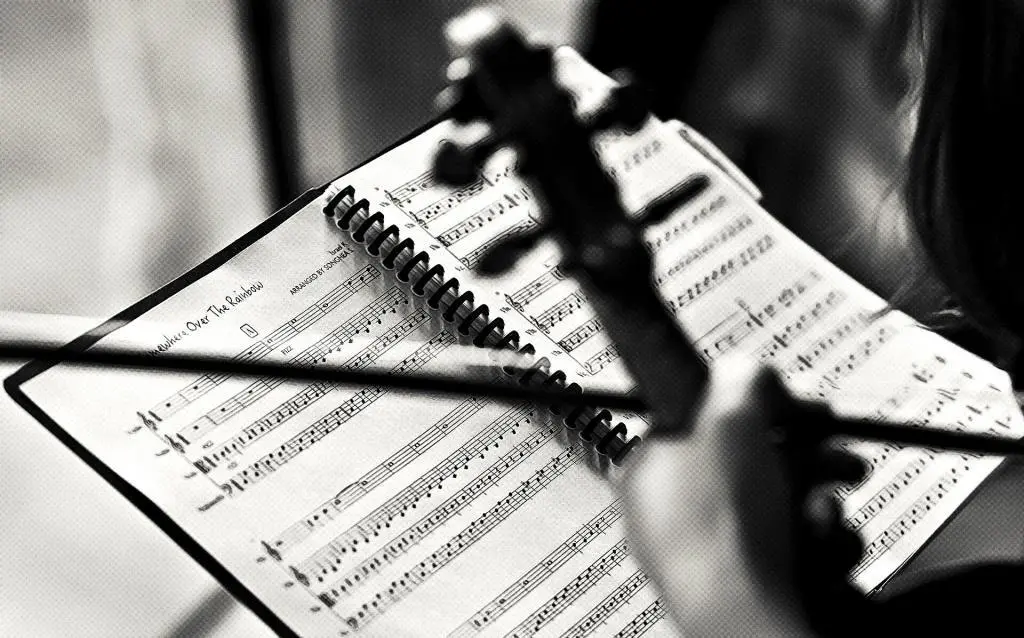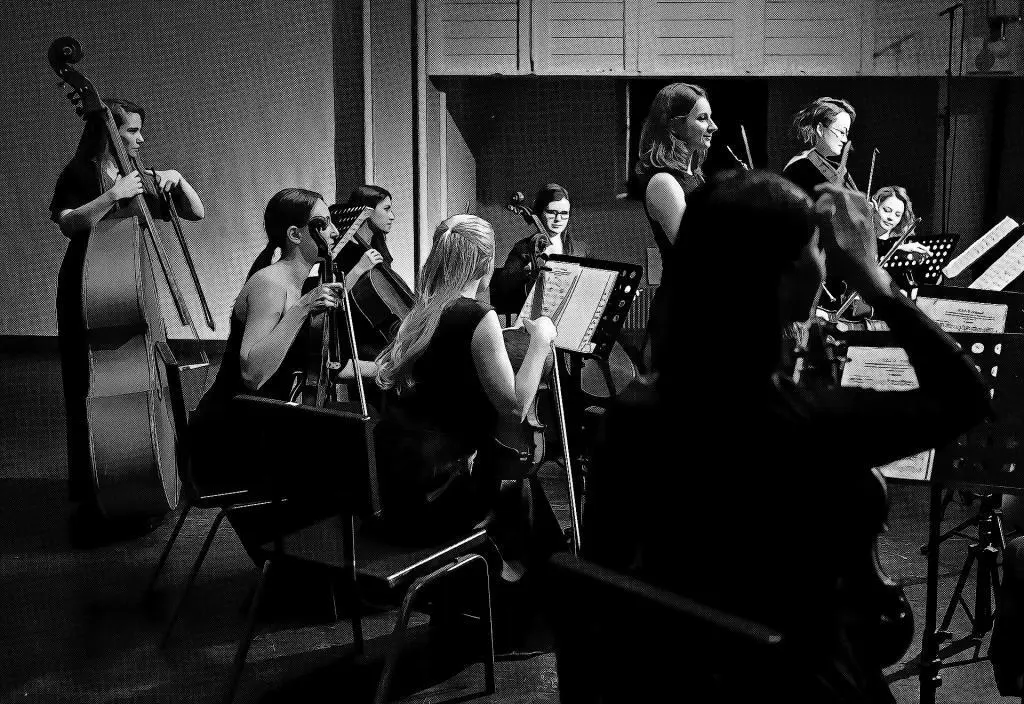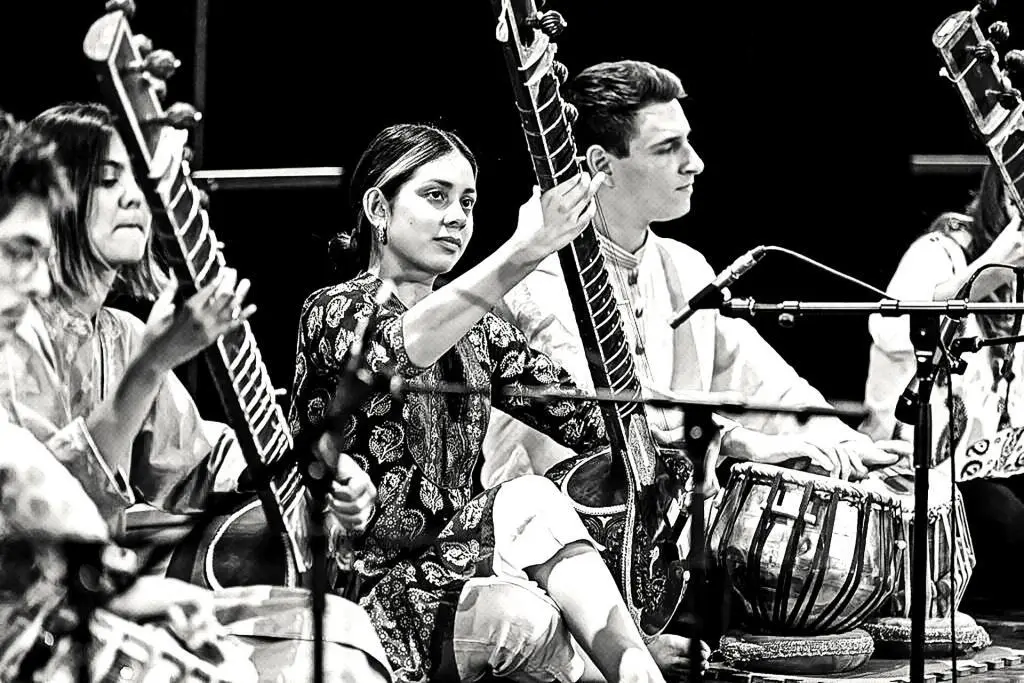In summary, largo is a tempo marking that indicates slow and stately pace, usually between 40-60 beats per minute, and it is often used in classical music to create a solemn or grandiose feeling.

What is Largo in Music: Table of Contents
Definition of Largo in Music
“Largo” is a tempo marking that is used to indicate that a piece of music should be played at a slow and stately pace. It is typically used in classical music compositions and is often associated with a solemn or grandiose feeling.
The tempo for largo is usually between 40-60 beats per minute which makes it slower than other common tempo markings such as Andante (moderately slow) and Allegretto (moderately fast).
“As the first notes of Beethoven’s Symphony No. 9 resonated through the concert hall, the slow and majestic tempo of the opening movement, marked as “largo”, enveloped the audience with a sense of solemnity and grandeur. The power of ‘largo’ in music is undeniable, captivating listeners with its profound emotional impact.
As noted in this article about “What is Largo” by Stephen Johnson, Jean-Jacques Rousseau established that largo was the slowest of all tempo markers in his Dictionary of Music (1768). Purcell and other English composers of the era perceived this tempo as falling between between adagio and andante. Rousseau’s definition eventually became the accepted one.
The “Handel’s Largo” aria from Handel’s Xerxes provides an illustration of the kind of intense emotional depth that Rousseau doesn’t expressly state, but by this stage appears at least semi-explicit. The diminutive larghetto is used in the initial marking, although this mistake is significant.
Stephen continues by pointing out that Haydn’s Quartet Op. 76 No. 5′s Cantabile e mesto slow movement is an illustration of the relatively intimate expressiveness intended for largo. Beethoven uses largo to denote a pace so slow that the music’s heartbeat is all but stopped in the nearly timeless opening of the Piano Sonata Op. 31 No. 2 (Tempest) and the concluding movement of Op. 106 (Hammerklavier).
Tempo, or the speed of music, is a fundamental element that greatly influences the overall mood and feel of a piece. It determines the pace at which the music unfolds, affecting its emotional character, expressive quality, and dramatic tension. Different tempos evoke distinct emotions, from fast and energetic to slow and contemplative, creating a rich palette of musical expressions.
Largo” in music is a specific tempo marking that is commonly used in classical music to convey a solemn or grandiose feeling. Its slow and stately pace captures the essence of profound emotions, from grief and lamentation to nobility and majesty.
The significance of “largo” in musical compositions lies in its ability to create a unique emotional landscape that resonates deeply with listeners, making it a defining element in the world of music.
Understanding Largo And a Brief History

“Largo” is is one of the slowest tempo markings commonly used in music, conveying a sense of spaciousness and solemnity in the music. The term originates from the Italian word for “wide” or “broad,” which reflects the expansive and unhurried nature of this tempo.
In musical notation, “largo” is often indicated by the Italian word “largo” or its abbreviation “L.” Other terms that are similar in tempo to “largo” include “grave” (very slow and solemn) and “adagio” (slow and leisurely). However, “largo” typically conveys a slower tempo than “adagio.”
The use of “largo” as a tempo marking has a rich history that spans across different musical traditions and styles. In addition to its prominence in Baroque and Romantic music, “largo” has also been utilized in other historical periods and cultural contexts.
In the Baroque era, which lasted from the late 16th century to the mid-18th century, “largo” was commonly employed by prominent composers such as Johann Sebastian Bach, George Frideric Handel, and Antonio Vivaldi. During this time, “largo” was often associated with sacred or contemplative music, reflecting the religious and meditative nature of the period. Composers of the Baroque era used “largo” in pieces such as choral works, oratorios, and sacred cantatas to create a sense of reverence and awe. The slow tempo of “largo” allowed for a gradual unfolding of the music, creating a contemplative and introspective mood.
In the Romantic era, which followed the Baroque era and lasted from the late 18th century to the late 19th century, “largo” continued to be used by composers such as Ludwig van Beethoven, Pyotr Ilyich Tchaikovsky, and Gustav Mahler. In Romantic music, “largo” was often used in symphonies, concertos, and choral works to evoke deep emotions and dramatic effects. Composers used the slow tempo of “largo” to create moments of longing, pathos, and intensity, allowing the music to unfold gradually and build emotional tension. “Largo” was often employed in Romantic music to create grandiose and expressive musical landscapes, showcasing the emotional depth and complexity of the Romantic era.
Beyond the Baroque and Romantic eras, “largo” has also found its place in other historical periods and cultural traditions. For example, in the Renaissance era, which preceded the Baroque era and spanned from the 14th to the 17th century, “largo” was used as a tempo marking in vocal and instrumental music to convey a sense of dignity and solemnity. In early music of the Middle Ages, “largo” was employed in plainchant and liturgical music to create a meditative and devotional atmosphere.
In addition to Western classical music, “largo” has also been utilized in various traditional and folk music styles from around the world.
For instance, in Indian classical music, “largo” is known as “alap” and is used in the beginning of a raga performance to establish the melodic framework and evoke a contemplative mood.

In Japanese traditional music, “largo” is used in the “ma” concept, which emphasizes the importance of silence and space between notes, creating a sense of tranquility and serenity.
Furthermore, in contemporary music, “largo” continues to be utilized by composers and performers in diverse genres and styles. In film music, “largo” can be used to underscore poignant or dramatic scenes, heightening the emotional impact of the visuals.
In jazz, “largo” can be employed to create slow and soulful ballads, allowing for expressive improvisation and emotional depth.
In ambient and experimental music, “largo” can be used to create immersive and introspective soundscapes, drawing the listener into a contemplative experience.
Phrasing and Expressive Nuances in “Largo”
Interpreting “largo” goes beyond adhering to a specific metronome marking. It requires an understanding of the mood and expression the composer intended to convey. The slow tempo of “largo” allows for a sense of gravitas, giving the music time to breathe and the listener time to fully appreciate the emotional nuances.
One of the key elements in interpreting “largo” is dynamics, or the variations in volume. Dynamics play a crucial role in shaping the emotional impact of the music. “Largo” often involves stark contrasts between soft and loud passages, creating a sense of tension and release. Careful attention to dynamics can help to heighten the sense of contrast and drama in the music, adding depth and expressiveness to the performance.
Phrasing, or the shaping of the melody, is another important consideration in interpreting “largo.” Long, sustained notes are often a characteristic of “largo,” and the phrasing should be carefully shaped to bring out the intended emotional impact of the music. Musicians need to pay attention to the natural ebb and flow of the melody, emphasizing certain notes or phrases to convey the intended mood and expression.
Expressive nuances such as rubato, which is the subtle stretching or compressing of time, can also be used in “largo” to add emotional depth and flexibility to the music. Rubato allows the performer to add personal expression and interpretation to the music, enhancing the overall emotional impact of “largo.”
Characteristics of Largo
“Largo” is typically associated with a grand, solemn, and contemplative mood in music. The slow tempo of “largo” often creates a sense of stateliness and grandeur, evoking feelings of awe, dignity, and reverence. The solemnity of “largo” can convey a sense of deep emotion, melancholy, or introspection, while the contemplative quality encourages reflection and introspection. The emotional characteristics of “largo” can vary depending on the context of the piece and the composer’s intentions, but it generally elicits a sense of profoundness and emotional depth.
Examples of musical compositions that exemplify the mood and emotional characteristics of “largo” include Samuel Barber’s “Adagio for Strings,” which is often performed at solemn occasions and funerals, and is known for its mournful and deeply emotional quality. The slow, spacious tempo and sustained notes in this piece contribute to its somber and contemplative mood, creating a sense of reverence and introspection. Another example is Ludwig van Beethoven’s “Symphony No. 9” (Second Movement), known as the “Largo” or “Adagio” movement, which features a slow tempo, spaciousness, and long sustained notes that convey a sense of solemnity, nobility, and emotional depth.
Several musical elements are often present in “largo” compositions that contribute to the overall musical experience for the listener.
One of the most prominent elements is the slow tempo, which sets the pace of the piece and creates a sense of expansiveness and grandeur. The slow tempo allows for the expression of deep emotions and encourages the listener to reflect and contemplate the music. The spaciousness in “largo” compositions is often achieved through the use of long sustained notes, which create a sense of lingering and resonance, adding to the majestic and solemn character of the music.
Additionally, the dynamics in “largo” compositions are often carefully chosen to create contrast and emphasize the emotional impact of the music. Dramatic contrasts between loud and soft passages can heighten the emotional intensity and add to the overall sense of grandeur and solemnity. The use of rich harmonies, deep bass lines, and lush orchestrations can also contribute to the majestic and expansive quality of “largo” compositions.
“Largo” has been used as a prominent tempo marking in many well-known musical compositions throughout history, showcasing its significance and enduring presence in music. For example, in Johann Sebastian Bach’s “St. Matthew Passion,” the aria “Erbarme dich, mein Gott” features a “largo” tempo, with its slow pace and sustained notes evoking a sense of deep emotion and contemplation, expressing the sorrow and repentance of the text. Another historical example is George Frideric Handel’s “Messiah,” specifically the aria “He was despised,” which is marked “largo” and is known for its mournful and introspective character.
In the Romantic period, composers such as Gustav Mahler and Pyotr Ilyich Tchaikovsky also used “largo” as a prominent tempo marking in their symphonies and orchestral works to convey a sense of grandeur, solemnity, and emotional depth. Mahler’s Symphony No. 5 (Fourth Movement) and Tchaikovsky’s Symphony No. 5 (Second Movement) are examples of “largo” movements that exemplify the characteristics of this tempo marking, with their slow tempos, spaciousness, and emotional intensity.
Performance Considerations for “Largo”
When performing music marked as “largo,” it is crucial for musicians to have a deep understanding of the historical context and emotional intent of the composition. Researching the composer’s intentions, the style of the piece, and the historical period in which it was composed can provide valuable insights into how to effectively interpret and perform the music. Understanding the historical context helps musicians grasp the stylistic elements, performance practices, and conventions of the time, which can inform decisions related to tempo, dynamics, articulation, and expression.
Interpreting “largo” requires careful consideration of various musical elements to convey the intended mood and feel of the music. Tempo is a critical aspect, and the performer must carefully choose an appropriate slow tempo that allows for the expression of deep emotions and contemplation, while maintaining a sense of flow and coherence. Dynamics play an essential role in “largo,” and the performer should pay close attention to the contrasting dynamics and use them to heighten the emotional impact of the music. Articulation also plays a crucial role in shaping the character of “largo,” with legato and sustained notes often used to create a sense of spaciousness and resonance. Expression is another important factor, and performers should strive to convey the intended mood, whether it is grand, solemn, mournful, or introspective, through careful phrasing, shaping of phrases, and use of appropriate musical gestures.
Performing “largo” can present challenges that musicians should be aware of and avoid. One challenge is maintaining a steady tempo, as the slow pace of “largo” can make it tempting to slow down excessively or speed up unintentionally. It is important to maintain a sense of pulse and flow while allowing for expressive nuances. Another pitfall to avoid is excessive rubato, which can disrupt the overall flow of the music and result in a lack of coherence. Rubato should be used judiciously and with the intention of enhancing the emotional impact of the music. Balancing dynamics is also crucial in “largo,” as overly aggressive or unbalanced dynamics can disrupt the intended mood and feel of the music. Careful attention should be paid to achieving a balanced and nuanced dynamic range that enhances the emotional depth of the piece.
Application of “Largo” in Different Genres
While “largo” is often associated with classical music, it is not limited to this genre alone. It can also be found in other genres, such as film music, ballads, and contemporary compositions. In film music, for example, “largo” can be used to create a sense of grandeur, solemnity, or introspection in dramatic or emotional scenes. In ballads, “largo” may be employed to evoke a sense of nostalgia, longing, or melancholy, adding emotional depth to the lyrics and melody. Contemporary composers and musicians also draw upon the characteristics of “largo” to create evocative and expressive compositions that transcend traditional genres and styles.
In various musical styles and traditions, “largo” is utilized to convey specific emotions or create particular atmospheres. For instance, in jazz or blues, a slow, spacious, and contemplative tempo can be used to express deep emotions, evoke a sense of longing, or create a soulful and introspective atmosphere. In electronic or ambient music, “largo” can be employed to create expansive soundscapes, immerse the listener in a contemplative mood, or convey a sense of vastness and tranquility. In world music traditions, “largo” may be utilized to express cultural or regional aesthetics, convey traditional storytelling, or create a meditative ambiance.
One of the remarkable aspects of “largo” is its flexibility and adaptability in different musical contexts. Composers and performers can creatively interpret and adapt “largo” to suit their artistic vision and the specific requirements of a piece of music. For example, a composer may choose to use a slower tempo to create a sense of grandeur and solemnity in a contemporary pop ballad, while a performer may use expressive rubato to convey emotional depth in a jazz piece marked as “largo.” “Largo” can also be combined with other musical elements or styles to create unique and innovative compositions that push the boundaries of traditional genres and styles.

